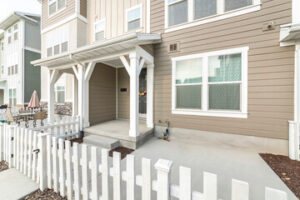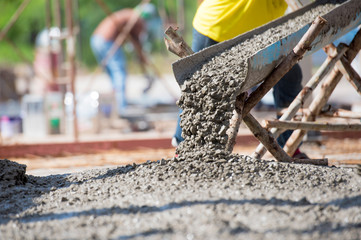Concrete patios offer a sleek, modern look that blurs the line between indoor and outdoor spaces. This elevated concrete patio features plenty of seating options and a built-in spa for a backyard oasis.
Install a rebar to make your patio stronger and less prone to cracking. You can purchase rebar from home improvement stores to create a grid pattern in your concrete patio. Click https://concretecontractorcoloradosprings.com/ to learn more.

A patio or walkway that slopes properly sheds water away from the home and prevents it from pooling and damaging outdoor furniture foundation walls and causing other moisture-related problems. A patio’s slope may also be called grade, pitch, angle, or fall. Depending on the rainfall and surrounding conditions, a patio’s slope can range from one-eighth to three-eighths of a foot for proper drainage. A patio’s slope is also affected by the sun and heat, which can cause it to sink or rise.
When constructing a new concrete patio, the slope is determined by a combination of factors, including how it will be built and the expected precipitation. A patio should be sloped enough to drain water to a storm sewer or French drain but not too steep to become dangerous or difficult to use. A typical slope for a concrete patio is a one-quarter-inch drop per foot, although this can vary by climate.
Using a 2- or 4-foot builder’s level, measure the distance from the building to the outer edge of the patio to determine the required slope. Then, divide that measurement by 48 to calculate the slope in inches. The result is the minimum slope for a patio surface within 10 feet of the house, which is 2%.
For existing patios that require re-sloping, the best way to do so is with a professional. Some mud-jacking companies inject a polyurethane or other slurry-type liquid under the pavers to lift them up and then stabilize them with sand or another material to hold them at their new elevation.
When pouring an elevated concrete patio, the site should be cleared of vegetation and filled with clean, leveled dirt (R506.2). A gravel drainage base or layer is laid and compacted (2″), followed by the forms for the slab. The slope of the forms should match that of the overall patio, preferably a 2% slope so that the concrete will lay evenly. Ideally, the concrete should be cast monolithic (R506.2.2) rather than precast slabs, but this is only sometimes practical.
Drainage is vital to the longevity of a concrete patio. Without it, water can pool and cause damage to the patio or soil underneath. In addition, water pooling can create a safety hazard for those using the patio. A properly installed drainage system can eliminate these issues and create a safe, functional patio. Assessing the patio’s drainage needs is important to ensure a proper drainage system before construction begins.
Evaluating the drainage needs of a concrete patio involves inspecting the patio and identifying areas where water may pool or collect. Look for water stains or discoloration on the patio and any low-lying areas that could be susceptible to flooding or standing water. Additionally, check for signs of moisture or dampness on the patio, including mold, mildew, or moss growth.
In many cases, a proper drainage system can be created by simply adjusting the slope of the patio slab or adding a drain. A drainage mat can also provide an efficient, durable solution for elevated concrete patios. These mats are made from UV-stable polyolefin and are designed to withstand the weight of concrete that will be poured on top of it. When installed correctly, a concrete slab can sit directly on top of the drainage mat without needing concrete formwork.
A French drain, a covered trench containing a perforated pipe or open aggregates (gravel with no small pieces), can also redirect the water flow away from an area. If you want to add a touch of elegance, consider using a channel drain in several colors designed to last.
Another option is to use a septic tank infiltration system, allowing water to be filtered through the tank before entering the soil below. This is a more environmentally friendly way to drain an elevated concrete patio, as it reduces the water pumped from the property. However, this method may require additional permits from local authorities.
Rebar is a form of raw steel that is used to add strength to concrete structures. Rebar can resist great shear forces without failure, which gives it an advantage over wood and other materials in structures that must support heavy loads or bear the weight of other building components. It is also a strong material in compression and can be bent to resist deformation, giving it an edge over other raw building materials that are not as flexible. Rebar can be made stronger through heat treatment and annealing processes.
When a homeowner is planning a large concrete slab, it is important to use rebar to avoid cracks and other problems that might develop later in the structure’s life. Rebar is especially needed when the concrete is poured in an elevated location, such as on a patio.
The rebar should be laid out in a grid pattern on the concrete before it is poured. The rebar will then be covered with cement, and metal rebar ties should be attached to the steel to keep it in place.
Several different types of rebar can be used for concrete projects. Black rebar is commonly used, and it is a relatively inexpensive material with excellent tensile strength. However, it corrupts, and that can adversely affect the concrete. An epoxy-coated rebar offers the same tensile strength as black rebar but is 1,700 times more corrosion-resistant.
Another option is stainless steel rebar. This type of rebar is more expensive, but it does not rust and has an even better tensile strength than black rebar. For a patio, rebar with a 3-inch diameter is recommended. This rebar will provide sufficient reinforcement for most slabs. Larger pads that will be used for heavy equipment or vehicles should have rebar of at least 5-inch diameter. Slabs that bridge backfilled ground or are exposed to freeze-thaw conditions should be reinforced, too. The rebar will improve the resistance of the concrete to washouts, tree roots, soil settling or shifting, and other environmental factors that might otherwise weaken it.
Concrete is a common patio material that costs less than most other materials. It can be customized with various finishes to create a unique look that complements your home. For example, plain concrete may be stamped or textured to resemble stone or brick. It can also be dyed or stained to almost any color. A concrete patio can also be made into a multi-level structure with stairs or an island.
A concrete patio can be poured directly into the ground or built on a subbase of gravel, crushed rock, cinder blocks, or even wood pavers. A poured concrete patio can support much weight, making it a good choice for sloped properties or those with limited space. Concrete is extremely durable and can withstand the elements without much maintenance.
Poured concrete typically has a gray, utilitarian appearance. However, a sand-based concrete mix can be colored and stamped to resemble other materials. It can be left with a smooth, textured surface or etched with acid stain to add an interesting design element to the patio.
A stamped concrete patio can cost more than a plain slab but is still cheaper than other materials, such as natural stone or pavers. It is also easy to install on a prepared site, eliminating the need for costly excavation or drainage work.
Before starting construction, you should call your local utility company to have any underground lines located and marked. Then, dig a hole to the correct depth for your patio foundation. Fill the hole with gravel to allow for proper compaction. Compose the gravel to form a level base for the concrete patio using a shovel.
For a more decorative finish to your concrete patio, you can use a hand-held power trowel to smooth and texture the concrete once it’s poured. After floating, add a broomed finish or seed with a small aggregate. Then, control joints in the concrete are cut using a grooving tool and a 2×4 straightedge guide. Once the concrete is dry, it s


